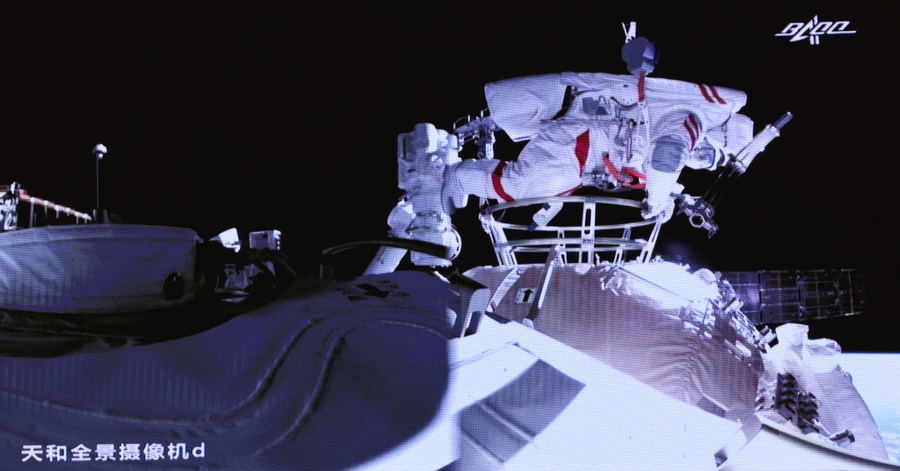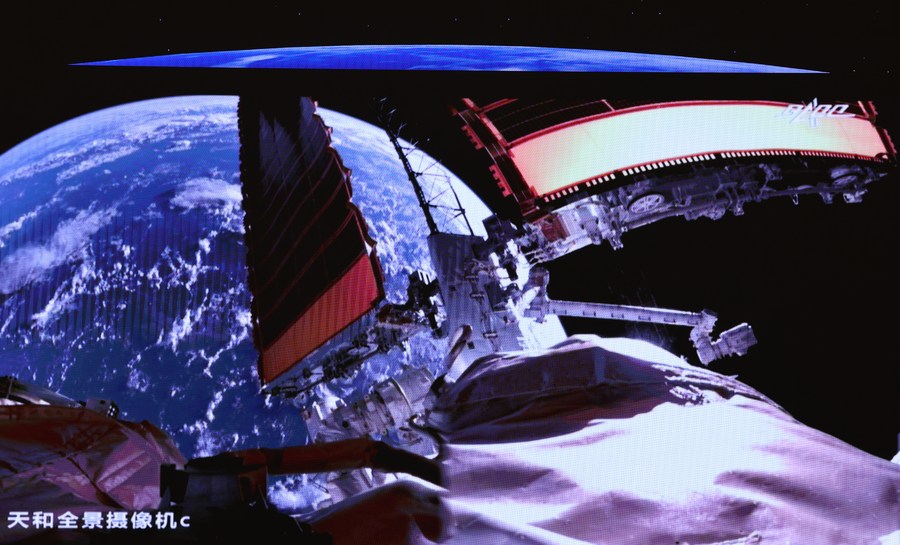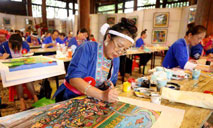Mechanical arm is Chinese astronauts' space helper

Screen image taken at Beijing Aerospace Control Center on July 4, 2021 shows Chinese astronaut Liu Boming slipping out of the space station core module Tianhe. (Xinhua/Jin Liwang)
BEIJING, July 5 (Xinhua) -- The mechanical arm installed on China's space station core module Tianhe has played an important role in assisting the astronauts with their extravehicular activities (EVAs) on Sunday.
The mechanical arm is designed to ensure the safe and reliable operation of the space station in orbit, to help the astronauts in EVAs, such as the assembly, construction, maintenance, and repair of the space station, and support space applications.
CRAWLING ARM
The 10.2-meter-long robotic arm installed on the Tianhe module can carry up to 25 tonnes of weight. It consists of seven joints, two limbs, two sets of extension gears, two sets of end cameras and end effectors (also known as end-of-arm tooling), one set of central controllers, and an elbow camera.
With limbs and joints, the mechanical arm can work as a human arm with a shoulder, an elbow, and a wrist. By rotating each joint, it can grasp the equipment and operate at any angle and position.
"The end effector of the arm can dock with a target adapter installed on the outer surface of the spacecraft. By docking and separation of the end effector and target adapter, the arm can crawl and move on the surface of the space station," said Wang Youyu, a mechanical arm designer at the China Academy of Space Technology (CAST).
In a computer illustrated video issued by the CAST, the arm, like an inchworm crawling with its head and rear, uses the two end effectors to move between the surface target adapters and reach multiple positions in the outer surface of the space station, where it can conveniently do its jobs.
In addition to working independently, the core module arm can also combine with the mechanical arms installed on the lab modules, which will likely be launched next year. The combined arm can reach a working diameter of 15 meters.
SPACE CONSTRUCTION
With a design life of 15 years, load capacity of 25 tonnes, and tip positioning accuracy of 45 millimeters, the mechanical arm installed on the Tianhe module can realize long-range, large-load operations and small-range, detailed operations.
The arm is designed for module transposition, astronauts' EVAs, extravehicular cargo handling, space station status inspection, and maintenance of large equipment, the CAST said.

Screen image taken at Beijing Aerospace Control Center on July 4, 2021 shows a view of the earth from the space station's perspective. (Xinhua/Jin Liwang)
For example, two lab modules will dock with the core module and form a T-shape complex. Restricted by the attitude control of the lab modules, they can't directly dock with the side docking ports of the core module.
Instead, each lab module has to dock with the front docking port of the core module, and then a smaller mechanical arm moves it to dock with the side port. The arm installed on the core module can also do the job as a backup.
Yang Hong, the chief designer of the space station at the CAST, said when a spacecraft is approaching to dock or in need of repair, maintenance, and supplies, the large-scale arm in the core module can help to secure the spacecraft and facilitate the procedure. The space station can be viewed as a homeport in space.
ASTRONAUT HELPER
The mechanical arm would reduce the burden of astronauts in extravehicular missions as much as possible, said Yang.
The end effector can dock with a foot restraint platform, where astronauts can stand. They can use the arm to send themselves to required locations.
"It can transfer the astronauts in a wide range so that they can easily reach the operation position during EVAs," he added.
The arm integrates mechanical engineering, mechanics, material, control, electronics, information, vision, and computer sciences technologies. With the ability of precise operation and visual recognition, it is capable of autonomous analysis and remotely controlled by astronauts.
Besides EVAs, the arm can also help astronauts transfer the solar wings of the core module and install the payloads on the outer surface of the station.
Equipped with cameras on the two ends and the elbow, it can also carry out extravehicular examinations for the astronauts.
"There are several areas on the station that need to be regularly checked by the robotic arm," said Hu Chengwei, another mechanical arm designer at the CAST.
"For instance, before the launch of the Tianzhou-2 cargo craft, we used it to monitor and evaluate the condition of the rear docking port of the core module in preparation for docking with Tianzhou-2," he added.
Photos
Related Stories
- Space technology behind Party flag in Tian'anmen Square flypast
- Story of China's first taikonaut's one day in space lights up internet, highlights country's space advancements
- "You can fly into space like Chang'e": mainland scientist cheers HK students on
- China's relay satellites facilitate clear, smooth space-ground communication
- China's space-tracking ship completes tasks for Tianzhou-2, Shenzhou-12 missions
Copyright © 2021 People's Daily Online. All Rights Reserved.










